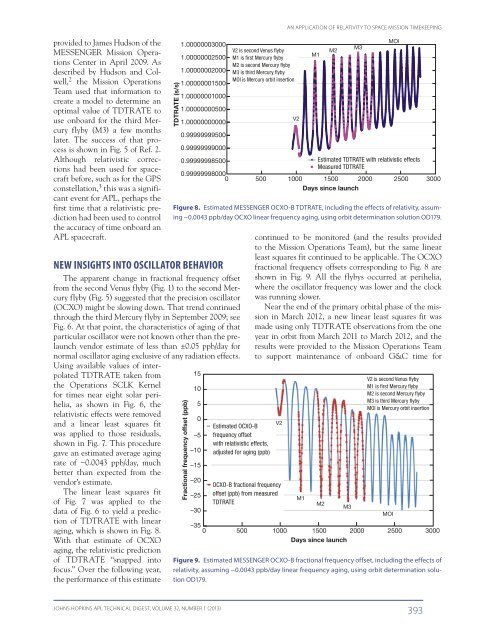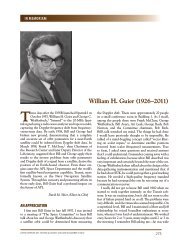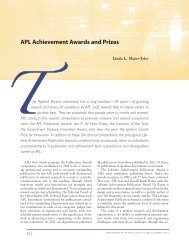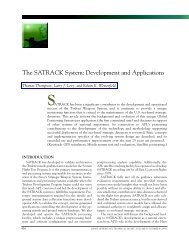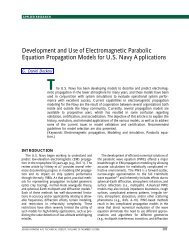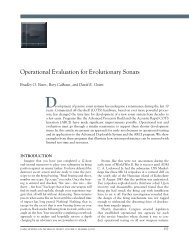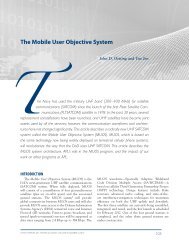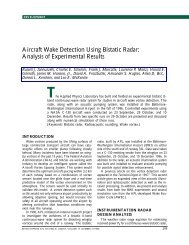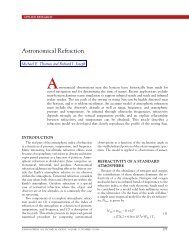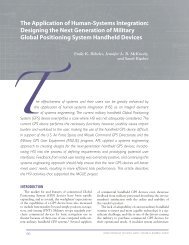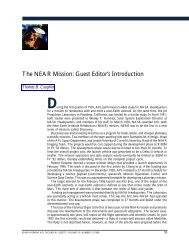A Practical Application of Relativity to Observation and Control of ...
A Practical Application of Relativity to Observation and Control of ...
A Practical Application of Relativity to Observation and Control of ...
You also want an ePaper? Increase the reach of your titles
YUMPU automatically turns print PDFs into web optimized ePapers that Google loves.
provided <strong>to</strong> James Hudson <strong>of</strong> the<br />
MESSENGER Mission Operations<br />
Center in April 2009. As<br />
described by Hudson <strong>and</strong> Colwell,<br />
2 the Mission Operations<br />
Team used that information <strong>to</strong><br />
create a model <strong>to</strong> determine an<br />
optimal value <strong>of</strong> TDTRATE <strong>to</strong><br />
use onboard for the third Mercury<br />
flyby (M3) a few months<br />
later. The success <strong>of</strong> that process<br />
is shown in Fig. 5 <strong>of</strong> Ref. 2.<br />
Although relativistic corrections<br />
had been used for spacecraft<br />
before, such as for the GPS<br />
constellation, 3 this was a significant<br />
event for APL, perhaps the<br />
first time that a relativistic prediction<br />
had been used <strong>to</strong> control<br />
the accuracy <strong>of</strong> time onboard an<br />
APL spacecraft.<br />
NEW INSIGHTS INTO OSCILLATOR BEHAVIOR<br />
The apparent change in fractional frequency <strong>of</strong>fset<br />
from the second Venus flyby (Fig. 1) <strong>to</strong> the second Mercury<br />
flyby (Fig. 5) suggested that the precision oscilla<strong>to</strong>r<br />
(OCXO) might be slowing down. That trend continued<br />
through the third Mercury flyby in September 2009; see<br />
Fig. 6. At that point, the characteristics <strong>of</strong> aging <strong>of</strong> that<br />
particular oscilla<strong>to</strong>r were not known other than the prelaunch<br />
vendor estimate <strong>of</strong> less than ±0.05 ppb/day for<br />
normal oscilla<strong>to</strong>r aging exclusive <strong>of</strong> any radiation effects.<br />
Using available values <strong>of</strong> interpolated<br />
TDTRATE taken from<br />
the Operations SCLK Kernel<br />
for times near eight solar perihelia,<br />
as shown in Fig. 6, the<br />
relativistic effects were removed<br />
<strong>and</strong> a linear least squares fit<br />
was applied <strong>to</strong> those residuals,<br />
shown in Fig. 7. This procedure<br />
gave an estimated average aging<br />
rate <strong>of</strong> −0.0043 ppb/day, much<br />
better than expected from the<br />
vendor’s estimate.<br />
The linear least squares fit<br />
<strong>of</strong> Fig. 7 was applied <strong>to</strong> the<br />
data <strong>of</strong> Fig. 6 <strong>to</strong> yield a prediction<br />
<strong>of</strong> TDTRATE with linear<br />
aging, which is shown in Fig. 8.<br />
With that estimate <strong>of</strong> OCXO<br />
aging, the relativistic prediction<br />
<strong>of</strong> TDTRATE “snapped in<strong>to</strong><br />
focus.” Over the following year,<br />
the performance <strong>of</strong> this estimate<br />
1.00000002500<br />
1.00000002000<br />
1.00000001500<br />
1.00000001000<br />
1.00000000500<br />
1.00000000000<br />
TDTRATE (s/s) 1.00000003000<br />
0.99999999500<br />
0.99999999000<br />
0.99999998500<br />
0.99999998000<br />
V2 is second Venus yby<br />
M1 is rst Mercury yby<br />
M2 is second Mercury yby<br />
M3 is third Mercury yby<br />
MOI is Mercury orbit insertion<br />
AN APPLICATION OF RELATIVITY TO SPACE MISSION TIMEKEEPING<br />
Estimated TDTRATE with relativistic effects<br />
Measured TDTRATE<br />
0 500 1000 1500 2000 2500 3000<br />
Days since launch<br />
continued <strong>to</strong> be moni<strong>to</strong>red (<strong>and</strong> the results provided<br />
<strong>to</strong> the Mission Operations Team), but the same linear<br />
least squares fit continued <strong>to</strong> be applicable. The OCXO<br />
fractional frequency <strong>of</strong>fsets corresponding <strong>to</strong> Fig. 8 are<br />
shown in Fig. 9. All the flybys occurred at perihelia,<br />
where the oscilla<strong>to</strong>r frequency was lower <strong>and</strong> the clock<br />
was running slower.<br />
Near the end <strong>of</strong> the primary orbital phase <strong>of</strong> the mission<br />
in March 2012, a new linear least squares fit was<br />
made using only TDTRATE observations from the one<br />
year in orbit from March 2011 <strong>to</strong> March 2012, <strong>and</strong> the<br />
results were provided <strong>to</strong> the Mission Operations Team<br />
<strong>to</strong> support maintenance <strong>of</strong> onboard G&C time for<br />
JOHNS HOPKINS APL TECHNICAL DIGEST, VOLUME 32, NUMBER 1 (2013) 393<br />
V2<br />
Figure 8. Estimated MESSENGER OCXO-B TDTRATE, including the effects <strong>of</strong> relativity, assuming<br />
−0.0043 ppb/day OCXO linear frequency aging, using orbit determination solution OD179.<br />
Fractional frequency <strong>of</strong>fset (ppb)<br />
15<br />
10<br />
5<br />
0<br />
–5<br />
–10<br />
–15<br />
–20<br />
–25<br />
–30<br />
Estimated OCXO-B<br />
frequency <strong>of</strong>fset<br />
with relativistic effects,<br />
adjusted for aging (ppb)<br />
V2<br />
OCXO-B fractional frequency<br />
<strong>of</strong>fset (ppb) from measured<br />
TDTRATE<br />
M1<br />
M1<br />
–35<br />
0 500 1000 1500 2000 2500 3000<br />
Days since launch<br />
M2<br />
M2<br />
M3<br />
M3<br />
MOI<br />
V2 is second Venus yby<br />
M1 is rst Mercury yby<br />
M2 is second Mercury yby<br />
M3 is third Mercury yby<br />
MOI is Mercury orbit insertion<br />
Figure 9. Estimated MESSENGER OCXO-B fractional frequency <strong>of</strong>fset, including the effects <strong>of</strong><br />
relativity, assuming −0.0043 ppb/day linear frequency aging, using orbit determination solution<br />
OD179.<br />
MOI


